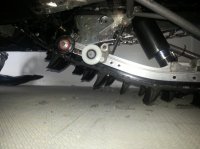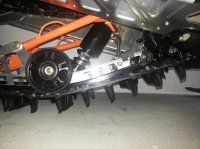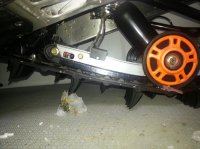TLRAK
Veteran
Nytro, 2012 Proclimb,07 M1000 pics with attack angle. Even know the angle looks close you can see that the AC set up seems to climb on the snow a little better. It might have to do with my location on the nytro, adn driver size. Also seems larger drivers could help this alot.
Attachments
Off Trail Mike
Gone Riding!
Guys:
Just so we are comparing apples to apples.
All Cat M/ProClimb Rails are around 20-21 degrees, no matter what the marketing material says. And the XF/ProCross a bit steeper (24-25ish). If you want to measure the angle, remove the rail from the sled and use a protractor of some kind (or do the angle math) and compare the flat section to the tipped up one. Measuring on your sled is sketchy at best. Is the ground you're on level? Did you install your skid level (don't laugh, the MTX Pro Mountain Air is deliberately not installed level from the factory)! Way too many variables.
Like Kennyspec, I built a model in CAD and reverse engineered the rail to make sure what I had on CAD was pretty much an exact match to what I had physically. At first I assumed the rail was 18 degrees as the "marketing" materials stated, but it didn't take me long with the measuring tape to figure out that the rail was steeper than advertized. I measured the AC rail, then a Timbersled and a (2010+) Yamaha and found they are all around 20-21, but advertized as 18....Don't know how they do their math????
So the 20-21 angle is pretty deliberate and it is a compromise, but a good one. Go much shallower and you give up too much of your ground clearance or shorten the flat section of your rail too much, and both have similar effects. I'd bet below 18, deep snow performance will suffer badly, cause if it didn't all the manufactures would do it and they don't (who cares what angle you run on the skid???). You may pop up on top of the snow awesome, but if you have more than a foot of it, you're going to drag your running boards.
So if the discussion is trenching, then yes shallower approach angle is better, but there is a limit. My Nytro, with the AC skid and Power Claw 2.25 x 15 x 153 trenches less in powder than my Skidoo Summit with a 2.6 x 16 x 154 and I place the blame squarely on the DS2 ski being too narrow for bottomless conditions making the front end push (and yes, I like the ski in more set up conditions, probably cause it is narrower!). I also think the PowerClaw is a very good track for floatation, as is the Camo Challenger.
I guess what I am saying is don't get too caught up on the approach angle. It's important but there are other equally (if not more) important factors to make a sled good in the snow: skis, track, weight distribution, etc.
Put it this way. On any given day when out riding with our group (RMK, XM, Nytro) my nytro is not stuck any more than any other sled.
OTM
Just so we are comparing apples to apples.
All Cat M/ProClimb Rails are around 20-21 degrees, no matter what the marketing material says. And the XF/ProCross a bit steeper (24-25ish). If you want to measure the angle, remove the rail from the sled and use a protractor of some kind (or do the angle math) and compare the flat section to the tipped up one. Measuring on your sled is sketchy at best. Is the ground you're on level? Did you install your skid level (don't laugh, the MTX Pro Mountain Air is deliberately not installed level from the factory)! Way too many variables.
Like Kennyspec, I built a model in CAD and reverse engineered the rail to make sure what I had on CAD was pretty much an exact match to what I had physically. At first I assumed the rail was 18 degrees as the "marketing" materials stated, but it didn't take me long with the measuring tape to figure out that the rail was steeper than advertized. I measured the AC rail, then a Timbersled and a (2010+) Yamaha and found they are all around 20-21, but advertized as 18....Don't know how they do their math????
So the 20-21 angle is pretty deliberate and it is a compromise, but a good one. Go much shallower and you give up too much of your ground clearance or shorten the flat section of your rail too much, and both have similar effects. I'd bet below 18, deep snow performance will suffer badly, cause if it didn't all the manufactures would do it and they don't (who cares what angle you run on the skid???). You may pop up on top of the snow awesome, but if you have more than a foot of it, you're going to drag your running boards.
So if the discussion is trenching, then yes shallower approach angle is better, but there is a limit. My Nytro, with the AC skid and Power Claw 2.25 x 15 x 153 trenches less in powder than my Skidoo Summit with a 2.6 x 16 x 154 and I place the blame squarely on the DS2 ski being too narrow for bottomless conditions making the front end push (and yes, I like the ski in more set up conditions, probably cause it is narrower!). I also think the PowerClaw is a very good track for floatation, as is the Camo Challenger.
I guess what I am saying is don't get too caught up on the approach angle. It's important but there are other equally (if not more) important factors to make a sled good in the snow: skis, track, weight distribution, etc.
Put it this way. On any given day when out riding with our group (RMK, XM, Nytro) my nytro is not stuck any more than any other sled.
OTM
kennyspec
Expert
Hey mike thanks for the reply and the cad file. Your comments all seem valid, I just figured if I was to build a tube frame sled why not build it "the best" it can be. I currently have a cat float skid in my nytro. I like the weight savings but it doesnt seem to transfer near as good as the modified mtx skid I had in it. Maybe I need to revisit my mounting locations again. Would revalving the shock to be a bit softer on the comprssion side help a bit? I have never really been a fan of float shocks.
Off Trail Mike
Gone Riding!
Kenny:
Agreed, the AC skid doesn't transfer as well. My XM is a wheelie king...more like a dirt bike.
I switched out the AC skid to a Timbersled and don't find it transfers very well either (mind you its coupled and is supposed to keep the front down), but I am still running recommended air pressures in both floats, so haven't experimented much.
Normally to transfer, you stiffen the front spring and soften the rear, and what I have found is the stock AC Fox Zero Pro tends to compress rather easily under power. I have gone as high as a 175 lb spring up front and tried a few shocks but could never get it to transfer that well.
OTM
Agreed, the AC skid doesn't transfer as well. My XM is a wheelie king...more like a dirt bike.
I switched out the AC skid to a Timbersled and don't find it transfers very well either (mind you its coupled and is supposed to keep the front down), but I am still running recommended air pressures in both floats, so haven't experimented much.
Normally to transfer, you stiffen the front spring and soften the rear, and what I have found is the stock AC Fox Zero Pro tends to compress rather easily under power. I have gone as high as a 175 lb spring up front and tried a few shocks but could never get it to transfer that well.
OTM
Similar threads
- Replies
- 2
- Views
- 526



